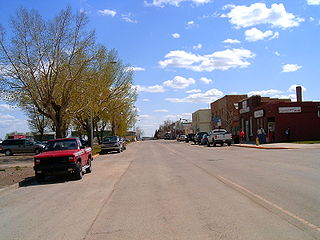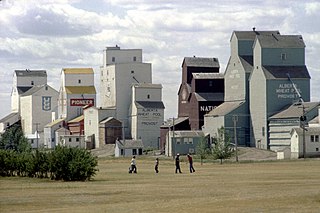
Wainwright is a town in east-central Alberta, Canada. It is approximately 206 kilometres (128 mi) southeast of Edmonton.

Turner Valley was a town in the Calgary Metropolitan Region of Alberta, Canada within the Town of Diamond Valley. It is on Highway 22, 3 km (1.9 mi) west of Black Diamond and approximately 60 km (37 mi) southwest of Calgary. It was named after Robert and John Turner who settled in the area in 1886.

Hinton is a town in west-central Alberta, Canada.

Elk Point is a town located in Eastern Alberta, Canada. It is located on Highway 41.

Forestburg is a village located in east-central Alberta, Canada. The rich farmland of the area was first settled by Europeans in 1905. Soon after the first of many "gopher hole" mines, homesteaders were soon coal mining on the banks of the Battle River in 1907.

St. Paul, originally known as St-Paul-de-Métis or St-Paul-des-Métis, is a town in East-Northern Alberta, Canada that is surrounded by the County of St. Paul No. 19. It was known as St. Paul de(s) Métis between 1912 and 1936.
Vermilion is a town in central Alberta, Canada that is surrounded by the County of Vermilion River. It is at the intersection of Highway 16 and Highway 41, approximately 60 kilometres (37 mi) west of Lloydminster and 192 kilometres (119 mi) east of Edmonton.

Stettler is a town in east-central Alberta, Canada that is surrounded by the County of Stettler No. 6.

Viking is a town in central Alberta, Canada. It is at the intersection of Highway 14 and Highway 36, approximately 121 km (75 mi) east of Edmonton.

Carstairs is a town in central Alberta, Canada. It is located on Highway 2A, 48 kilometres (30 mi) north of Calgary, the nearest major city, and 241 kilometres (150 mi) south of the provincial capital, Edmonton. The closest neighbouring communities are the towns of Didsbury and Crossfield. Carstairs is located entirely within the rural Mountain View County.

Ponoka is a town in central Alberta, Canada. It is located at the junction of Highway 2A and Highway 53, 59 kilometres (37 mi) north of Red Deer and 95 kilometres (59 mi) south of Edmonton.

Mannville is a village in central Alberta, Canada. It is located at the intersection of the Yellowhead Highway and Highway 881, approximately 22 kilometres (14 mi) west of Vermilion and 170 kilometres (110 mi) east of Edmonton. Its primary industry is agriculture.

Daysland is a town in central Alberta, Canada. It is on Highway 13, approximately 43 kilometres (27 mi) east of Camrose.

High Prairie is a town in northern Alberta, Canada within Big Lakes County. It is located at the junction of Highway 2 and Highway 749, approximately 89 km (55 mi) northeast of Valleyview and 118 km (73 mi) west of Slave Lake.

Innisfail is a town in central Alberta, Canada. It is located in the Calgary-Edmonton Corridor, south of Red Deer at the junction of Highway 2 and Highway 54.

Provost is a town in central Alberta, Canada. It is located at the junction of Highway 13 and Highway 899, 19 km (12 mi) west of the Alberta-Saskatchewan border. It was originally named "Lakeview" but renamed by the Canadian Pacific Railway Land Department in 1907; the first train to the town was in 1910. Post office established in 1908.

Smoky Lake is a town in Central Alberta, Canada. It is located 116 km (72 mi) northeast of Edmonton at the junction of Highway 28 and Highway 855. It lies between the North Saskatchewan River, Smoky Creek, and White Earth Creek, in a mainly agricultural area. The provincial historic site of Victoria Settlement is nearby. Long Lake Provincial Park is located 60 km (37 mi) north of the town. The Woods Cree, a First Nations people, named "Smoking Lake" for the smoke from ceremonies performed on the shore; the name Smoky Lake may also be based on the mist that rose from the lake in great quantities at sundown. One of its churches, the St. Onuphrius Ukrainian-Catholic, built in 1907, has been moved to the Canadian Museum of History in Gatineau, Quebec. It is in Census Division No. 12 and is the municipal office for Smoky Lake County.

Caroline is a village in central Alberta, Canada. It is located southwest of Red Deer.

Starland County is a municipal district located in southern Alberta, Canada.

Blackie is a hamlet in Alberta, Canada within the Foothills County. It is located approximately 70 kilometres (43 mi) southeast of Calgary on Highway 799.





















